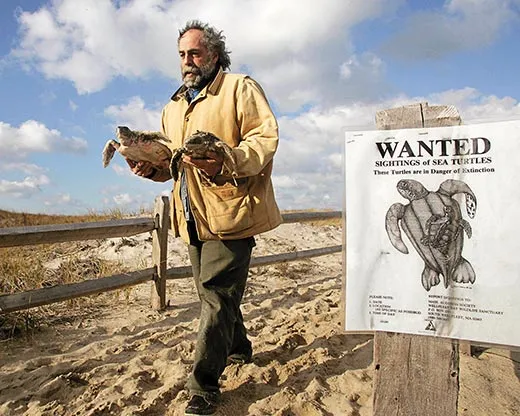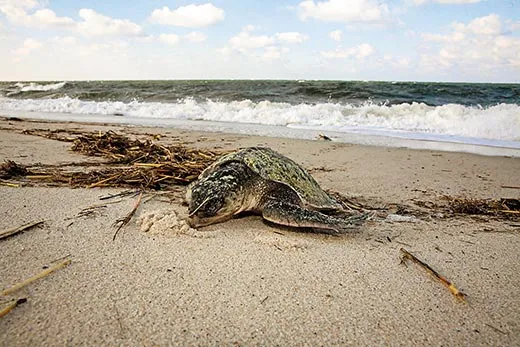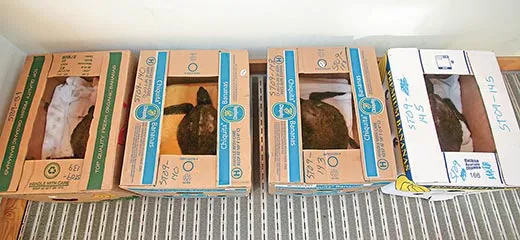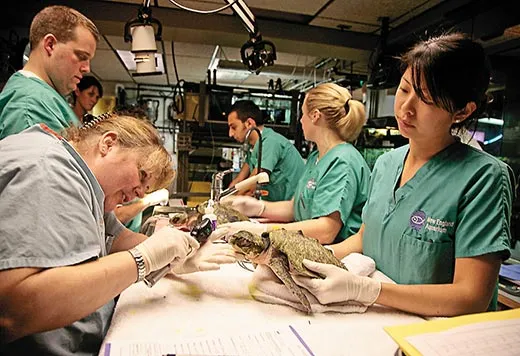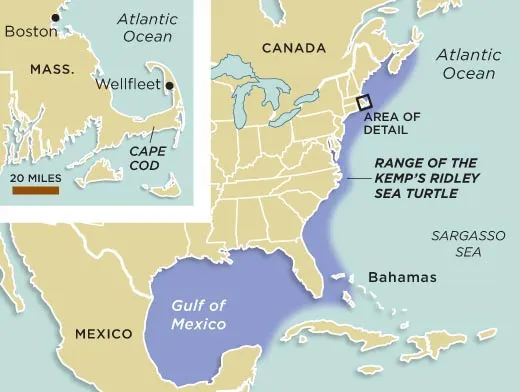Saving the World’s Most Endangered Sea Turtle
Stranded on Cape Cod beaches, these Kemp’s ridley turtles are getting a helping hand from volunteers and researchers
/https://tf-cmsv2-smithsonianmag-media.s3.amazonaws.com/filer/Phenomena-sea-turtles-Cape-Cod-631.jpg)
Cape Cod Bay churns as a frigid gust flicks froth into the air and the surf claws at the beach. I find a tangle of black seaweed on the sand, lift a handful of the wet mess and glimpse the lines of a shell. I grab more seaweed and uncover what I’ve been searching for: a Kemp’s ridley turtle, a member of the world’s most endangered species of sea turtle.
It’s a long way from the beach in Mexico where the turtles almost certainly hatched. It’s so still I doubt it’s alive. I pull off my gloves, lift the animal by its foot-wide shell and trot down the beach, holding it in front of me like a priceless porcelain vase. The turtle slowly raises its plum-size head and pops open its small eyes. One flipper flutters, then another. The turtle begins to paddle in the air, as if swimming. I sprint to my car.
Sea turtles already crowd the foyer when I arrive at the Massachusetts Audubon Society’s nature center in Wellfleet. People hustle to put each animal on a clean towel in a cardboard box that once held bananas. Here and there a flipper waves, but most of the turtles are motionless. One exhales raspily. Volunteers plucked six turtles off beaches this morning and seven last night. Two are green turtles and the rest are Kemp’s ridleys. “I doubt there is a room in the world right now that has this,” says Dennis Murley, a naturalist at the center.
Each fall, typically by late October, Kemp’s ridleys and other sea turtles start washing up on the 50-mile-long shoreline along Cape Cod Bay between Sandy Neck and Provincetown. The turtles, almost all juveniles, are thought to follow warm summer currents north to Maine or beyond; then, as fall approaches, they head south before inadvertently swimming into the bay formed by the great crooked cape. As the water temperature drops, so does the coldblooded animal’s body temperature, until the turtle sinks into a deep torpor, too weak to find its way out of the bay. Turtles do occasionally wash up on other beaches along the East Coast, but only on Cape Cod are substantial numbers found every year.
About half of the turtles on the beach are already dead. The others, called cold-stunned turtles, will die of hypothermia if left on the sand, says Murley, because the air is even colder than the water.
He and Bob Prescott, the Audubon center’s director, weigh and measure the turtles. Some move frantically; the one I found, whose shell is coated with algae and has been given the number 93, starts doing the crawl stroke again. Prescott touches the motionless ones on the back of their heads or at the corner of their eyes, looking for a reaction that will tell him they’re alive. “Sometimes you can’t even tell from that,” Prescott says. The center keeps any turtle presumed dead for at least 24 hours. Over the years, Murley says, a few of these have revived. “Lazarus turtles,” he calls them.
Most Kemp’s ridley turtles nest along Mexico’s Gulf coast, but some nest in Texas. This is one of only two sea turtle species that lay eggs in mass nesting groups called arribadas. (The other species, the olive ridley, lives in the Atlantic and Pacific oceans.) Some young Kemp’s ridleys are thought to swim from the Gulf of Mexico to the Sargasso Sea, in the middle of the Atlantic. As they mature, they paddle west toward shallower water along the coast of North America, where they can live for decades. The world’s smallest sea turtles, they grow about two feet long.
Vast numbers of Kemp’s ridleys once nested simultaneously; in 1947, a beachgoer filmed some 42,000 turtles on a beach in Mexico. Unfortunately for the species, people liked to eat the eggs, which were easy to harvest, and thought they acted as aphrodisiacs. By the 1960s, the turtle population had plummeted. Mexico outlawed the harvest in 1966, but poaching continued to take a toll. Meanwhile, increasingly scarce adults were often caught in fishing gear. In 1985, only 702 turtle nests were found, the lowest number on record. With new, turtle-excluding fishing nets and better protection of their nesting beaches, the species has begun to recover. An estimated 8,000 females nested last year.
Prescott says the population increase may explain why more Kemp’s ridley turtles have recently been found along Cape Cod. When he came across his first one, in 1974, he didn’t know what it was doing there. By the 1980s, maybe ten a year washed in, some of them still alive. Prescott and Murley organized a few people to comb the beaches in autumn and early winter. In 1999, they found a record 278, of which 219 were Kemp’s ridleys. Since then, the center has maintained a corps of about 100 volunteers, nearly all retirees.
“The easy part is finding them on the beach,” Prescott says. “The hard part is the medical treatment.”
After the turtles are bundled up at Wellfleet, volunteers and staffers transport them to a clinic at the New England Aquarium in Boston. The clinic is crammed with microscopes, computers and medical equipment as well as tanks of blue water that gurgle and hum.
“Welcome to the real world, Bud,” a volunteer in surgical scrubs says to a turtle that she plucks out of a box. She lays the seemingly lifeless animal on an examining table. Jill Gary, a biologist with the aquarium, sinks a needle into the back of its neck and draws out thick, maroon-colored blood. Gary squirts yellow antiseptic into the animal’s eyes and checks the cornea for scratches. The volunteer has been holding a monitor to the turtle’s heart. “I’ve had only one heartbeat so far,” she says.
Gary inserts a rectal thermometer into the turtle and the animal springs to life. Its temperature is 53.8 degrees Fahrenheit, about 20 degrees below normal. Gary, however, is in no rush to change that.
When people at the aquarium began treating cold-stunned sea turtles extensively, in the mid-1990s, little was known about hypothermia in the animals. Through trial and error and the testing of various medications, they have figured out how to save about 80 percent of the turtles brought into the aquarium.
Charlie Innis, the aquarium’s head veterinarian, says the animals die if they warm up too quickly. As the turtle’s temperature rises, pathogenic bacteria that have lain dormant in its body also revive. The turtle’s immune system, compromised by hypothermia, isn’t up to the fight. The turtles are also susceptible to fungal infections. The main danger is pneumonia—about 20 percent of the turtles have it when they arrive, and perhaps 25 percent will contract it here.
The biologists have learned it’s best to warm the turtles by about five degrees a day. After each turtle is examined, it is tucked into a square, temperature-controlled contraption that is basically a turtle refrigerator. The temperature is set near the turtle’s core body temperature and turned up slightly each day.
At the clinic, a turtle with a body temperature in the 60s is plopped into a waist-high water tank to see how it swims. A volunteer watches to see if it’s strong enough to lift its head to breathe. It does, but just barely.
The blood-test results begin to come in from the lab equipment on the other side of the clinic. Most of the turtles are hypoglycemic, a sign that they are starving, and their electrolytes are out of balance, indicating that they are dehydrated. They will be injected with fluids and antibiotics for days, even months in some cases.
The turtle beaching season ends in January; after the water temperature drops to about 40 degrees, nearly all the turtles that wash in are dead. This year volunteers found 200 turtles, the third highest catch. Eighty-five were alive and sent to the aquarium. The staff named the turtles after parks in the United States. The one I found got named Voyageurs, after a national park in northern Minnesota.
The aquarium needed to make room for new arrivals, so it shipped out the turtles that were strong enough to travel. Voyageurs and 16 other survivors were sent to the University of New England in Maine. Three went to the National Aquarium in Baltimore, four to the Woods Hole Aquarium in Falmouth, Massachusetts, and three to the Riverhead Foundation on Long Island. The rest, 33 Kemp’s ridleys and the three greens, stayed in Boston.
Connie Merigo, a biologist who manages the rescue effort, chooses when to release the sea turtles, usually in late summer. She monitors local sea temperatures, waiting for the water to reach about 70 degrees, and keeps track of turtle sightings offshore, a sign that conditions in the water are good. The turtles are released in Nantucket Sound, where they will have fewer obstacles on their route south. Identification tags will be placed on all animals and several will also receive satellite tags that record where they go.
Last summer, for the first time, a turtle rescued from Cape Cod Bay and tagged at the New England Aquarium was spotted nesting on a beach on Padre Island in Texas. Adam Kennedy, an aquarium biologist, says the rescue team got word of the nest at the beginning of this year’s stranding season. The news made it easier to gear up for the coming days of pressure-filled work. “It’s just really exciting,” he said. “That’s what we are here for.”
Amy Sutherland’s most recent book is What Shamu Taught Me About Life, Love and Marriage.
